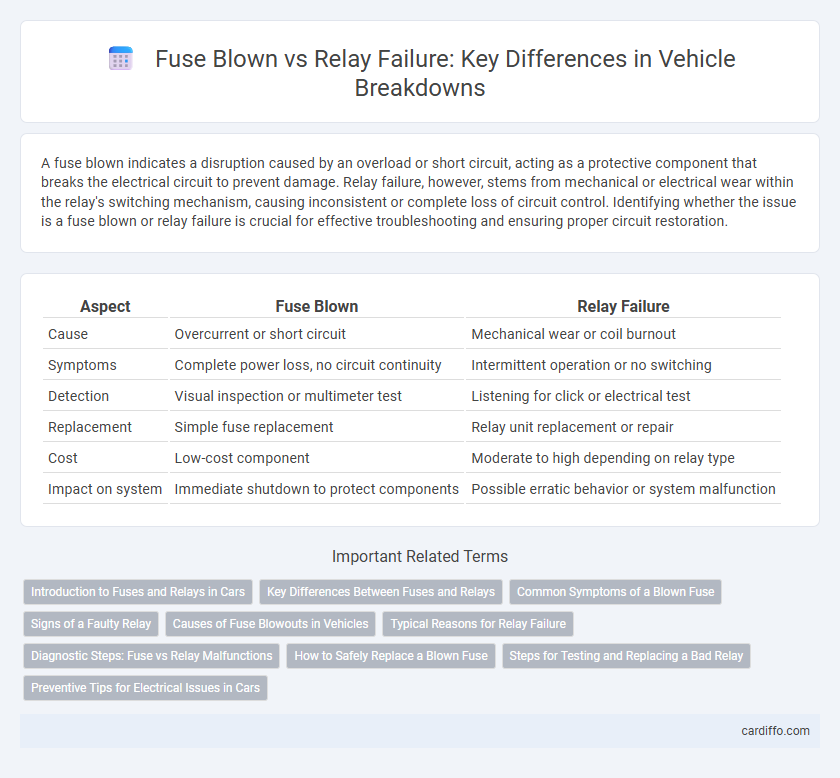A fuse blown indicates a disruption caused by an overload or short circuit, acting as a protective component that breaks the electrical circuit to prevent damage. Relay failure, however, stems from mechanical or electrical wear within the relay's switching mechanism, causing inconsistent or complete loss of circuit control. Identifying whether the issue is a fuse blown or relay failure is crucial for effective troubleshooting and ensuring proper circuit restoration.
Table of Comparison
| Aspect | Fuse Blown | Relay Failure |
|---|---|---|
| Cause | Overcurrent or short circuit | Mechanical wear or coil burnout |
| Symptoms | Complete power loss, no circuit continuity | Intermittent operation or no switching |
| Detection | Visual inspection or multimeter test | Listening for click or electrical test |
| Replacement | Simple fuse replacement | Relay unit replacement or repair |
| Cost | Low-cost component | Moderate to high depending on relay type |
| Impact on system | Immediate shutdown to protect components | Possible erratic behavior or system malfunction |
Introduction to Fuses and Relays in Cars
Fuses and relays are essential electrical components in vehicles, designed to protect circuits from damage and control high-current devices respectively. A fuse contains a thin wire that melts when excessive current flows, preventing circuit overload, while a relay uses an electromagnetic switch to manage power flow to critical systems like headlights and fuel pumps. Understanding the distinct roles of fuses and relays is crucial for diagnosing common electrical breakdowns in automotive systems.
Key Differences Between Fuses and Relays
Fuses provide overcurrent protection by melting a thin wire inside when excessive current flows, effectively breaking the circuit to prevent damage, whereas relays are electrically operated switches that control a circuit by opening or closing contacts without direct current interruption. Fuse failure is typically irreversible and requires replacement, while relay failure often involves mechanical contact wear or coil issues that may be repairable or replaceable. Understanding these differences enables precise troubleshooting and optimized maintenance in electrical systems.
Common Symptoms of a Blown Fuse
A blown fuse typically causes electrical components to stop functioning abruptly, such as headlights, radio, or dashboard lights going dark. Common symptoms include a complete loss of power in specific circuits, intermittent power issues, or a distinct burning smell near the fuse box. Unlike relay failure, which may cause erratic or delayed component operation, a blown fuse results in total current interruption for the affected circuit.
Signs of a Faulty Relay
Signs of a faulty relay include intermittent electrical failures, such as flickering lights or erratic operation of automotive components like the fuel pump or ignition system. A relay that clicks repeatedly without activating the connected device indicates internal contact wear or coil failure. Unlike a blown fuse that cuts off power completely, relay failure often causes inconsistent circuit behavior and diagnostic trouble codes related to electrical malfunctions.
Causes of Fuse Blowouts in Vehicles
Fuse blowouts in vehicles primarily occur due to electrical overloads that exceed the fuse's amperage rating, causing it to melt and interrupt the circuit. Short circuits and faulty wiring contribute significantly by creating sudden surges of current that the fuse cannot handle. Prolonged use of damaged or corroded components also increases resistance, generating heat that leads to fuse failure.
Typical Reasons for Relay Failure
Relay failure typically results from coil burnout due to excessive voltage, contact wear caused by frequent switching, and mechanical fatigue from vibration or contamination. High inrush currents can cause contact welding, while corrosion or dirt within the relay can impair electrical connections. Unlike fuse blows triggered by overcurrent protection, relay failures are often linked to operational stress and environmental factors.
Diagnostic Steps: Fuse vs Relay Malfunctions
Diagnosing fuse blown versus relay failure requires systematically testing electrical continuity and component function. Begin by inspecting the fuse with a multimeter to check for an open circuit indicating a fuse blowout, then assess the relay by applying voltage to coil terminals and verifying switch actuation. Understanding the role of each component in the circuit, such as load protection by fuses and signal control by relays, helps pinpoint accurate fault sources.
How to Safely Replace a Blown Fuse
To safely replace a blown fuse, ensure the vehicle's ignition and all electrical components are turned off to prevent electrical shocks or short circuits. Use a fuse puller or insulated pliers to carefully remove the damaged fuse without touching the metal parts. Always replace the fuse with one of the exact same amperage rating to avoid further electrical system damage or potential fire hazards.
Steps for Testing and Replacing a Bad Relay
Testing and replacing a bad relay starts with identifying the relay location using the vehicle's service manual or relay diagram. Use a multimeter to check continuity and coil resistance, ensuring the relay is not stuck or damaged; swapping the suspect relay with a known good one can confirm functionality. If the relay is faulty, disconnect the battery, carefully remove the old relay, and install the new one, verifying proper operation by testing the circuit under normal conditions.
Preventive Tips for Electrical Issues in Cars
Regular inspection of fuses and relays helps prevent unexpected electrical failures in cars by identifying wear or corrosion early. Ensuring proper wiring insulation and secure connections reduces the risk of short circuits that can cause fuse blowing or relay malfunction. Utilizing high-quality replacement parts and avoiding aftermarket components minimizes compatibility issues and extends the lifespan of the vehicle's electrical system.
Fuse blown vs relay failure Infographic

 cardiffo.com
cardiffo.com